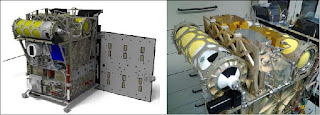 |
| PSLV-C34 Credits - ISRO |
ISRO launches and successfully deploys 20.... YES.....20 satellites together into there respective orbits, on board PSLV-C34 on June 22nd 2016, from the Satish Dhawan Space Centre, Sriharikota.
The 20 satellites include,
1. Cartosat-2 series satellite (India) - Primary Satellite
After the satellite is brought to its final operational configuration, it will begin to provide remote sensing services using its panchromatic (black and white) and multispectral (colour) cameras.
The images sent by the Cartosat-2 series satellite will be useful for cartographic applications, utility management like road network monitoring, water distribution, creation of land use maps, precision study, change detection to bring out geographical and man-made features and various other Land Information System (LIS) and Geographical Information System (GIS) applications.
2. SATHYABAMASAT (India)
This satellite was made by Sathyabama University, Chennai. Its main objective is to collect data on green house gases like, CO2, CO, Water vapour, CH4 and HF.
3. SWAYAM (India)
This satellite was made by College of Engineering, Pune. It will be used to provide point to point messaging services to the HAM community.
 |
| LAPAN-A3 |
4. LAPAN-A3 (Indonesia)
It is a micro-satellite, meant for multi spectral remote sensing for environmental monitoring, land use and natural resources.
5. BIROS (Germany)
It stands fro 'Berlin Infrared Optical System', and it is a small satellite for the German Aerospace Center ((DLR). Its objective is to remote sense the high temperature events.
 |
| M3MSat |
6. M3MSat (Canada)
It stands for 'Maritime Monitoring and Messaging Micro-satellite'. It is actually a technology demonstration mission. Its mission is to collect and study the Automatic Identification System (AIS) signals form the low-Earth orbit.
7. GHGSat-D (Canada)
It is an Earth observation satellite made by the Space flight Laboratory at the University of Toronto Institute of Aerospace studies. It would be used for measuring the atmospheric concentration of the greenhouse gases (CO2 and CH4).
8. SkySat Gen2-1 (USA)
It is a small imaging satellite built by Terra Bella, a google company based in Mountain View, California. It will be capturing sub-meter resolution imagery and HD videos.
9. Twelve Dove Satellites (USA)
These are also Earth imaging satellites. They were carried inside three QuadPack dispensers. It is the Flock-2P.








